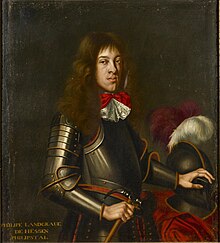Philipp (Hessen-Philippsthal)
Philipp von Hessen-Philippsthal (born December 14, 1655 in Kassel ; † June 18, 1721 in Aachen ) was paraged Landgrave of Hessen-Philippsthal from the House of Hesse from 1663 to 1721 .
Life
Philip was the third son of Landgrave Wilhelm VI. von Hessen-Kassel and his wife Hedwig Sophie von Brandenburg . He founded the Hessen-Philippsthal sideline without sovereignty.
In his father's will, he was only given a pension. From his mother's inheritance, he received, among other things, half of the castle and the Barchfeld hereditary bailiwick . In 1678 , after the von Wersebe family died out , he received the Herleshausen castle and estate from his brother, the Kassel Landgrave Karl , initially as a fief and finally as a property. In 1683 Philip took part in the Battle of the Kahlenberg . In order to establish a permanent residence, Philipp was assigned the former Kreuzberg (or Kreuzburg) monastery on the Werra, where he had the Philippsthal Palace built in 1685 . On July 5, 1694, he was accepted into the Order of the Elephants by King Christian V , the highest Danish knightly order . When he retired from his military career around 1707, he decided to live in The Hague . That year he bought land and a house on Scheveningseweg, which he had torn down to build a modest castle , which he called "Hessenhof". Philip's niece, Duchess Élisabeth Charlotte d'Orléans , later wrote that she had heard that he had lived there as a Dutch citizen and raised his sons as farmers. His neighbor in The Hague was the Dutch-English courtier and diplomat Count Johann Wilhelm Bentinck . When he was temporarily in Aachen in 1721 , he died there of a stroke . He was first buried in Maastricht . In 1723 his body was moved to The Hague, where he was buried in the Great Church . His widow erected a grave monument there, designed by the architect Daniel Marot . Katharina Amalie von Solms-Laubach was also buried there later. The castle was later renamed "Huis Buitenrust". It was inhabited by Queen Anna Pavlovna in the 19th century and demolished in 1912 for the construction of the garden of the Peace Palace .
ancestors
| Moritz Landgrave of Hessen-Kassel (1572–1632) | |||||||||||||
| Wilhelm V Landgrave of Hesse-Kassel (1602–1637) | |||||||||||||
| Agnes zu Solms-Laubach (1578–1602) | |||||||||||||
| William VI. Landgrave of Hessen-Kassel (1629–1663) | |||||||||||||
| Philipp Ludwig II of Hanau-Münzenberg (1576–1612) | |||||||||||||
| Amalie Elisabeth von Hanau-Münzenberg (1602–1651) | |||||||||||||
| Katharina Belgica of Orange-Nassau (1578–1648) | |||||||||||||
| Philip of Hesse-Philippstal | |||||||||||||
| Johann Sigismund Elector of Brandenburg , (1572–1620) | |||||||||||||
| Georg Wilhelm Elector of Brandenburg (1595–1640) | |||||||||||||
| Anna of Prussia (1576–1625) | |||||||||||||
| Hedwig Sophie of Brandenburg (1623–1683) | |||||||||||||
| Friedrich IV. Elector of the Palatinate (1574–1610) | |||||||||||||
| Elisabeth Charlotte of the Palatinate (1597–1660) | |||||||||||||
| Luise Juliana of Orange-Nassau (1576–1644) | |||||||||||||
progeny
On April 16, 1680 Philipp married Katharina Amalie (1654–1736), daughter of Count Karl Otto von Solms-Laubach in Kassel , with whom he had the following children:
- Wilhelmine Hedwig (1681–1699)
- Karl (1682–1770), Landgrave of Hessen-Philippsthal, ⚭ 1725 Princess Katharina Christine of Saxe-Weimar-Eisenach (1699–1743)
- Amalie (1684–1754)
- Amonen (1685–1686)
- Philipp (1686–1717), ⚭ 1714 Countess Marie von Limburg-Styrum (1689–1759)
- Friederike Henriette (1688–1761)
- Wilhelm (1692–1761), Landgrave of Hesse-Philippsthal-Barchfeld, ⚭ 1724 Princess Charlotte of Anhalt-Bernburg (1704–1766)
- Sophie (1695–1728), ⚭ 1723 Duke Peter August von Holstein-Beck (1696–1775)
Web links
- http://www.retrobibliothek.de/retrobib/seite.html?id=128600
- http://genealogy.euweb.cz/brabant/brabant12.html
- Hessen-Philippsthal, Philipp Landgrave of. Hessian biography. (As of December 14, 2019). In: Landesgeschichtliches Informationssystem Hessen (LAGIS).
Remarks
- ^ Th. Morren: Zorgvliet, Buitenrust en Rustenburg. , Elsevier's Geïllustreerd Maandschrift (German: Elsevier's illustrated monthly report) , Volume XIII, Volume 2 (July-December), 1903
| predecessor | Office | successor |
|---|---|---|
| - |
Parent Landgrave of Hessen-Philippsthal 1663–1721 |
Charles I. |
| personal data | |
|---|---|
| SURNAME | Philip |
| ALTERNATIVE NAMES | Hessen-Philippsthal, Philipp von (full name) |
| BRIEF DESCRIPTION | Landgrave of Hessen-Philippsthal from the House of Hessen (1663–1721) |
| DATE OF BIRTH | December 14, 1655 |
| PLACE OF BIRTH | kassel |
| DATE OF DEATH | June 18, 1721 |
| Place of death | Aachen |


